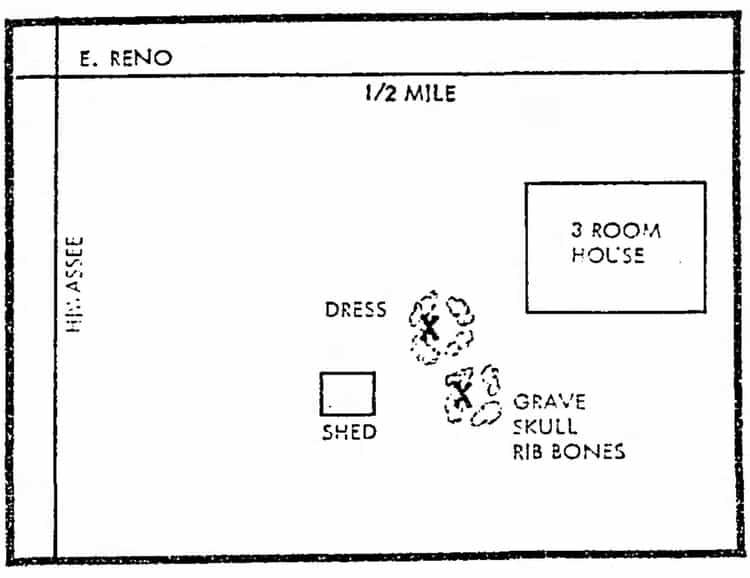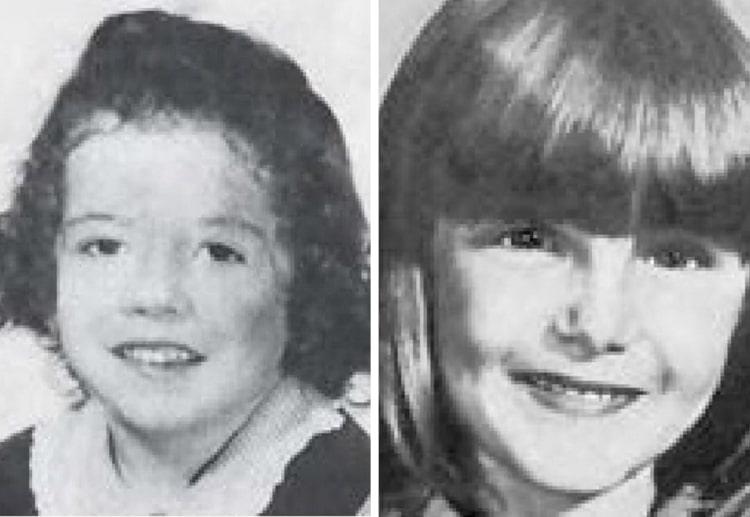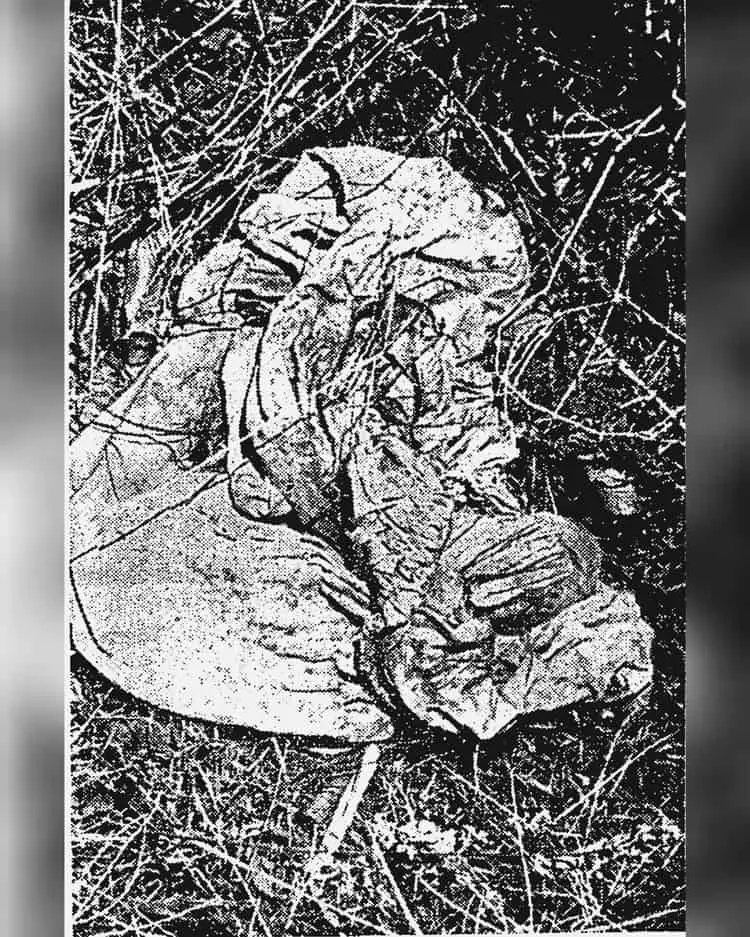OKLAHOMA CITY, Okla. — Judith Ann Elwell, 5, was a lovely child with long, curly raven hair, dark brown eyes, and long black eyelashes.
The Elwell family resided in a small single-story home at 1114 N. Meta Ave.
At the age of eight, her father, James Elwell, witnessed his mother shoot his father to death. A few months later, she committed suicide.
Elwell was drafted into the Army while in the 11th grade. Two weeks after his honorable discharge, he had a nervous breakdown and was ruled 90 percent disabled. Afterward, he started drawing a monthly veteran’s disability check.
Elwell received a bachelor’s degree in entomology, the study of insects, from Oklahoma State University in 1951.
By 1967, he had held numerous primarily short-lived laborer jobs, despite his education. In July of that year, he was working at a service station.
Elwell might not have achieved his career goals, but he was happy with his wife and children living in their modest home, earning an honest living.
Like most little girls, Elwell’s daughter, Judith, loved to play with dolls. Her favorite toy was her 11-inch, blond-haired doll, “Mary Anne.”
She also loved to play outside with the neighborhood children. Judith usually never strayed too far from home unless accompanied by her playmates.
One day, Judith went outside to play and was never seen again.
Disappearance of Judith Elwell
Judith was last seen by her mother, Lola Elwell, sometime between 6:30 p.m. and 8:30 p.m. on July 6, 1967. She asked her mother to put pink hair ribbons in her doll’s hair. Afterward, Mrs. Elwell heard Judith return outside to play in the backyard.
At 8:50 p.m., Elwell returned home from work. He noticed Judith was not waiting for him outside in the front yard near the bush like she usually did.
After a failed search for his daughter, he called the police.
Elwell recalled years later that Judith had told her mother about a scary dream a month before she disappeared.
“Mommy, I cried last night because a big black car came up to the yard and got me.”
In hindsight, the dream seemed prophetic.
An extensive search for the little girl began. The Daily Oklahoman reported it was” one of the longest, most exhaustive and involving more persons than any other in several decades of Oklahoma City history.” It involved more than 300 searchers and encompassed more than 10 square miles on foot. Police, the Civil Air Patrol, civilians, firefighters, and citizens band radio operations all participated.
Firefighters dragged ponds and swamps in a general area near the state fairgrounds, about two miles south of the Elwell home.
Searchers checked abandoned wells, a deep brick quarry a mile east of the Elwell home, and the South Canadian River. They also checked storm sewers and junked cars.
On July 7, searchers found one of Judith’s blue canvas shoes in an area directly behind and east of her home.
Searchers combed the area but found nothing else. A couple of days later, they thought they found the other shoe in a different location, but it was not Judith’s.
Two days after Judith’s abduction, police abandoned the fruitless search and launched a full-scale investigation.
Detectives extensively interviewed the Elwells at the police station, searched their home, and dug up their yard but never implicated them in the abduction. Police also checked into local sex offenders, including several outside Oklahoma, but came up empty.
Investigators followed several leads, including two people seen in a dark blue or green sedan, music blaring, parked just north of where searchers found her shoe. Police traced the car and determined it was not involved in Judith’s abduction.
On July 11, detectives staked out a Yukon apartment complex, investigating a possible suspect, but that led nowhere.
A few days later, police distributed missing person fliers to every city in Arizona, Arkansas, Kansas, Missouri, New Mexico, and Oklahoma.
Police had a couple of theories in Judith’s abduction, later discounted. Judith had fallen into an oil tank at the north edge of the fairgrounds near NW 10th Street, where children often played. Or burglars abducted her after she possibly observed them stashing their loot.
It seemed like the investigation was going to turn cold until another little girl disappeared into thin air, too.
Abduction of Brenda Lois White
Brenda Lois White was born on Nov. 22, 1960, to Bobbie Joe and Connie White and resided at 10147 St. Patrick Dr. in Midwest City.
She was last seen at 3:30 p.m. on Aug. 3, 1967, at Pop’s Grocery Store on the northeast corner of Post Road and St. Patrick Drive, a block west of her home. Her bicycle remained outside the store.
Police immediately believed Brenda and Judith’s abductions were connected due to the similarities and launched a massive search for Brenda. More than 400 people were involved, including police, Tinker Air Force Base personnel, horseback riding clubs, and more, but they did not find Brenda.
Over three months later, on Nov. 19, two quail hunters, W.E. Brace and C.M. Whitt were walking past an abandoned farmhouse outside Harrah looking for quail when Brace stumbled upon a human skull. The men immediately notified authorities, who subsequently found dozens of bones at the scene, as well as a tattered blue-and-white dress and underwear.
Police scoured the area but did not find any other clues helpful to the investigation.

Kenneth Anderson, 40, a Tinker Air Force Base employee, was the closest neighbor; he lived about 100 yards northwest of the farmhouse.
He told the police that he saw two men walking across an 80-acre section of land he owned adjoining his home around the time of Brenda’s disappearance. The men parked their car near an isolated area on Reno Avenue and later were seen walking across a field carrying a shovel, bucket, and boards. Police never identified the men.
On Nov. 23, Brenda’s mother identified the tattered dress as one she had made herself for Brenda.
A few days later, state medical examiner Dr. James Luke ruled Brenda’s death a homicide but said her cause of death was “undetermined due to advanced post-mortem decomposition and partial recover of skeletal remains.”
A month later, an anthropologist examined the remains and also failed to determine the cause of death.
Police questioned several possible suspects but never arrested anyone for Judith’s abduction and Brenda’s murder.
In 1969, the probe into the local cases expanded east to Connecticut after Mary Mount, 10, was abducted on May 27. Searchers consequently found one of her shoes, like in Judith’s case. Three weeks later, two teenagers found Mary’s body while trying to find a fishing spot near a reservoir. Mary had suffered a fatal blow to the head. Police never caught her killer, and the case remains unsolved. Local authorities were unable to link Mary’s case with Judith and Brenda’s.
The Oklahoman reported in 2013 that “police also compared the Oklahoma cases to the death of a seven-year-old Texas girl but determined the similarities were probably coincidental.”
There were a few similarities between the Elwell and White cases, but nothing beneficial to investigators.
The girls were close in age and vanished during daylight hours when several people were outside, and children played in their front yards, yet no one witnessed the abductions.
The abductions occurred at the beginning of the month while their mothers were home and their fathers worked.
In each case, a witness saw a strange car in the area of the girls’ homes around the time they disappeared. A witness in Judith’s case saw a vehicle parked near a grove of trees east of the child’s home. In Brenda’s case, a neighbor youth thought he saw her in a car with a man the day she vanished. Police were unable to confirm either vehicle being in the area.
Police never found any solid clues that would have led them to the girls’ killer or killers.
Fast forward to 2013.
Man Begins Own Investigation
Troy Thiessen of Lawton began freely investigating the cases and claimed he knows who killed both girls. However, he refused to reveal the man’s identity until he had enough evidence to present to the investigators.
Thiessen, a private investigator, came across Judith’s case in 2011 while researching another project.
Thiessen spoke with Rhonda Miller, an Oklahoma City resident, who had a scary encounter in September 1967, a month after Brenda’s abduction.
She was walking home after school one afternoon on NW 96th Street when a man in a white Plymouth began following her. The driver pursued her through her neighborhood until she safely made it into the home of a friend. Miller believes he was the person responsible for Judith and Brenda’s abductions.
Miller told Thiessen the man was a white male with darker skin, possibly tanned from the sun, wore glasses, and had dark hair, The Daily Oklahoman reported. Thiessen emailed Miller numerous pictures of his primary suspects, but she did not recognize any of them. However, 46 years had passed when she viewed the photos, and she likely could not remember all of the details.
The Elwell and White cases remain unsolved nearly 54 years later. For several years after Judith’s abduction, her father wrapped Christmas gifts and placed them under the tree in case she returned home. Her mother died from cancer in 1973.
Brenda’s father, Bobbie Joe White, passed away on July 24, 2014, at age 81.
*9:30 a.m.: I just realized I did not put my “thoughts” on this one at the end of the post before hitting the publish button! Oops! I’ll add them over the weekend!*
True Crime Diva’s Thoughts
I added this section on 05/1/2021 because I completely forgot to include my thoughts on this one on the day of publishing. How, you ask, when I have done this for over 10 years? I have no clue. All I have to say on that is don’t get old. It sucks.
Judith Elwell and Brenda White lived only about 17 miles from one another. Both were taken on the first Thursday of the month. I feel that whoever abducted and killed them was from the OKC area, maybe closer to where Brenda was taken or disposed of.
It is less than 10 miles east from where Brenda was abducted to where the killer/killers disposed of her body. The latter area was probably pretty remote in 1967 because there are only a few houses in that location even today. It might suggest a familiarity with the place.
If you’re wondering about the 2-hour time frame when Lola Elwell last saw Judith, 1967 articles said it was 6:30 and a 1974 one said 8:30.
I believe the killer/killers took the girls for sexual reasons. There might have been two involved if we trust Anderson’s sighting of two men near Brenda’s dumpsite. But I wonder if police ever looked at him as a possible suspect. He was a local familiar with the OKC area and lived near the dumpsite. Furthermore, he did not report the sighting of the men until AFTER Brenda’s body was found. He had to have known about her abduction because the local news extensively covered both kidnappings. That makes me a wee bit suspicious of him.
I think we should also look at the possibility that these two cases are not related.
Judith was taken from her backyard, whereas Brenda’s kidnapper took her from a public location. It could mean Judith’s kidnapper either knew Judith or had stalked her in the days leading up to her disappearance.
If she knew the person, she might have voluntarily left with him.
Brenda’s abduction feels more like a moment of opportunity to me. Her kidnapper saw her in or outside the store and took advantage of the young girl being alone.
The two girls looked nothing alike. A pedophile often has a type he prefers. And while the kidnappings both occurred in OKC, the city metropolitan area had a population of 501,000 in 1967. Even though the crimes occurred a month apart, there is a chance the cases are not related.
Police were wholly focused on one suspect in both kidnappings that they did not even look at the possibility of separate killers.
I’m shocked that not one person had witnessed Brenda’s abduction. She was taken outside a grocery store at 3:30 p.m. Did police interview store employees who were working at that time? What about customers?
I’m curious who Thiessen thinks killed the girls and if he is still investigating the case.





